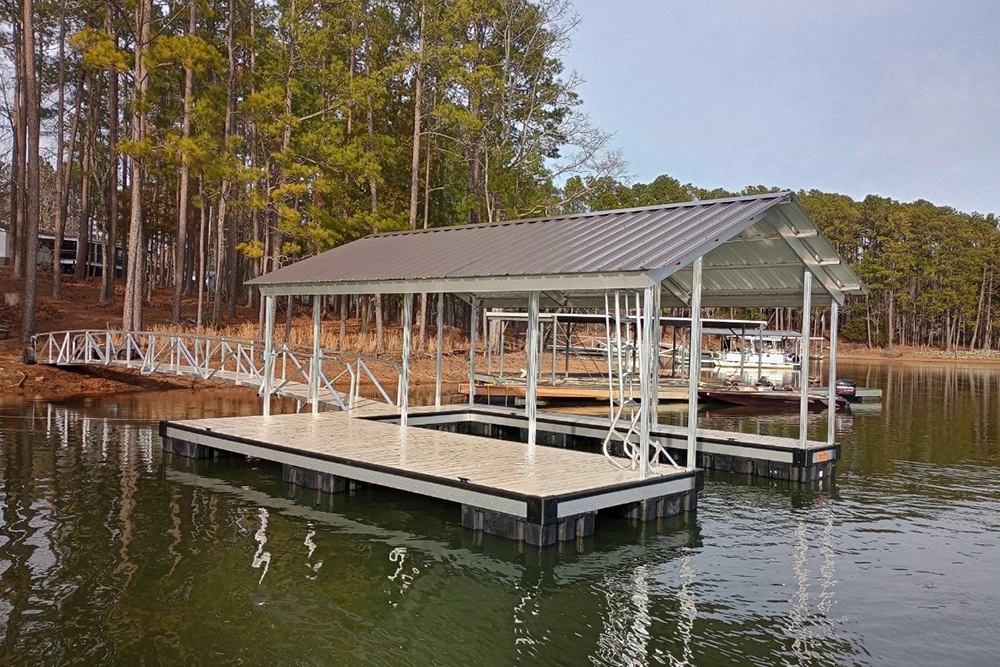Decks are large structures that need solid foundations to remain safe. If the posts are not properly secured, they can shift, crack, or sink over time and present both safety risks and costly repair expenses, eventually! The best way for stability is post footings. They are concrete pads used to distribute the weight of a deck over an expansive surface area and offer stability in unstable soil conditions. We have prepared a complete guide on how to prevent deck posts from sliding downhill.
Install Retaining Walls for Added Support
Retaining walls provide an efficient solution for sloped landscapes, turning them into usable areas for relaxing and entertainment. Retaining walls also add stability to the dock as well as aesthetic appeal that increases property value.
These walls can also act as protection against erosion caused by runoff water that damages the foundations of the dock, plus wood rot damage caused by runoff flooding. Retaining walls prevent soil movement and provide stability on minor slopes, especially where this prevents dirt from sliding forward during landslides or other forms of danger.
Installed properly, retaining walls can serve to support decks that have been constructed into hillside areas of your home. Understand how to anchor a floating dock for stability!
Use Helical Piers & Tiebacks
Helical piers (also referred to as screw piles) can help secure walls supporting your new deck, including its walls. They consist of long steel shafts with an array of helical plates welded onto them that resemble screw or auger teeth. This allows it to twist into stable soil layers deeper than originally anticipated, increasing reach into load-bearing strata.
Installation
Once a helical pier has reached its required depth, a bracket is installed to connect it with the structure it supports. After that, helices are then twisted into the earth until they’re securely in place. Since they don’t require excavation for installation, helical piers can be set up much more rapidly and without risk.
Once helix piers are installed, their bracket can be removed, and construction of decks or other structures may begin. Helical piers can be used during new construction and renovation to prevent costly repairs later.
Benefits
Helical piers offer many advantages over different types of wooden posts in terms of protecting them from moisture-induced decay and other environmental influences, which means involving an expert helical pier contractor early in your project to make sure there are enough helical piers in strategic places for maximum support.
Proper Footing Installation
Footings are concrete bases used to support the posts and joists on your deck. With proper type and quality footings in place, they can prevent your deck from gradually sinking downward over time.
- Before beginning to dig any footing holes, always contact your local building codes department to ensure you do not interfere with underground utility wires.
- Once granted permission to dig, carefully dig footing holes that extend 12 inches below the frost line.
- Once the holes are dug, install a precast concrete tube form in each one.
- A concrete tube allows builders to skip mixing and pouring their own concrete on site and opt instead for this quick and cost-effective option.
- Submersion footings provide another approach for deck footings.
This method of construction is typically employed when regulations prevent wood posts from touching the soil directly. Because submerged footings lack as much support, these options should only be utilized with low-profile decks located in areas with firm soil conditions.
Improve Drainage System Around the Deck
When building on a sloped terrain, proper drainage is important to its long-term safety and sustainability. Excess water that pools on the deck surface may lead to wood rot, mould, and mildew growth, and foundational issues. Hence, lower lifespan and safety risks!
- Step one of improving drainage on a deck is inspecting for areas of standing water following a rainfall event.
- Search for areas where deck board gaps are inconsistent or too narrow.
- These gaps obstruct water flow and must be paid special attention to in areas nearer your home.
Maintenance Tips for Long-Term Stability of Boat Dock
Like everything else, boat docks’ proper maintenance can make all the difference. By following some straightforward strategies, your dock will continue looking its best over the years ahead.
1. Tighten Loose Fasteners
Floating docks must withstand everything from summer sun to winter storms, which requires regular inspection of their hardware. At these inspections, any loose fasteners must be tightened if necessary.
Loose screws and nails protruding from wooden planks or rotting boards pose serious safety concerns as they could cause people to trip or catch splinters in their feet. Addressing these concerns early is vital for avoiding more severe complications later.
2. Regularly Inspect for Pest Infestations
Creatures such as squirrels and ducks can do incredible damage to a dock. Their teeth can tear through canvas materials, chew through wires and hoses, and leave behind droppings.
Search for pest infestations such as ants, carpenter bees, or termites quickly and take swift action against them. A professional can treat the area with an insecticide safe for marine life if necessary.
3. Clean the Dock
Proper dock maintenance can significantly lower the risk of snow-related dock damage. Tidal areas in particular must take special note of adjusting anchor chains. Thoroughly cleaning the dock regularly will rid it of debris, algae, and stains without harming surfaces.
By regularly inspecting and cleaning pilings, dock owners can protect the structural integrity of their dock and extend its lifespan.
4. Apply a Fresh Coat of Stain
Your dock’s wood requires protection from both moisture and harsh sunlight, so choose a marine-grade stain that can stand up against these environmental forces. Research various stain options based on project requirements and read user reviews in order to select the ideal product.
Professional stainers apply a fresh coat of stain in thin layers that follow the wood grain, as per the manufacturer’s specifications. Allowing it to dry can take anywhere between several hours and an entire day.
5. Repair Broken Parts in the Outdoor Space
Even small issues like loose boards can turn into major headaches over time if left ignored, which will eventually lead to costly repairs in the form of higher utility costs and costly repair bills. Therefore, it is important that any necessary repairs be completed immediately.
Regularly clean your dock using a pressure washer set on a low setting, avoiding using high-pressure spray as this may erode and split wood surfaces. Plus, always go for environmentally-friendly cleaners that do not wash directly into the water.
Final Thoughts
The same principle applies: stability and longevity come from proper planning, solid construction, and regular upkeep. On the water side, your dock demands the same kind of attention. Strong foundations, smart design, and steady maintenance are the keys to keeping your outdoor spaces safe, stable, and ready for years of enjoyment.
Build a Dock That Lasts with Foothills Docks
When it comes to building a dock, there’s a big difference between doing it yourself and having it done right the first time. That’s where Foothills Docks comes in. We’ve spent years installing docks that stand up to the unpredictable conditions of our local waters. Contact our team for a free estimate!







